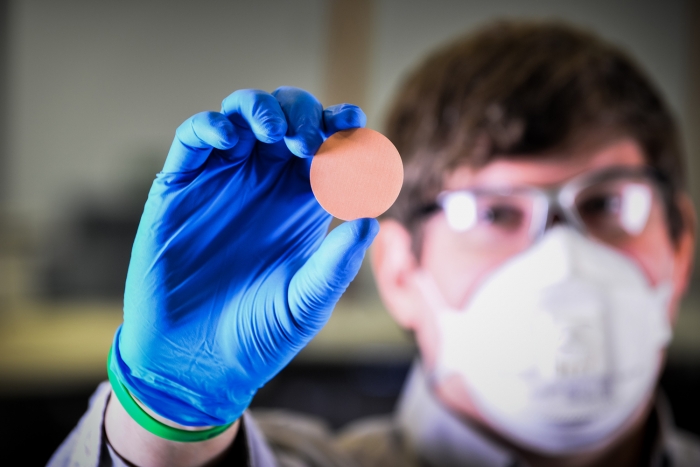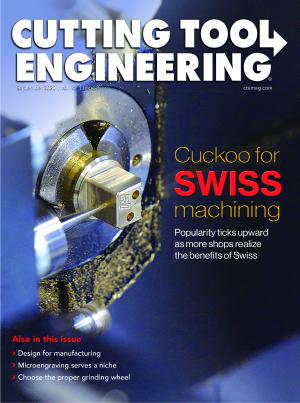The ExOne Co. in North Huntingdon, Pennsylvania, and the University of Pittsburgh have partnered to develop reusable metal filters that fit into a specially designed respirator cartridge for sustainable, long-term protection from contaminants.
ExOne’s binder jetting technology is a high-speed form of 3D printing that can produce metal parts with specific porosity levels that effectively can filter out contaminants while allowing airflow.
The company has 3D-printed respirator filters using two metals — copper and 316L stainless steel — and a range of porosity levels for use inside a unique cartridge designed by the Department of Mechanical Engineering and Materials Science at Pitt’s Swanson School of Engineering. Initial testing for airflow and filtration efficiency is underway, and the filters are being optimized with the goal of adhering to an N95 respirator standard.

A reusable, sterilizable copper filter has been 3D-printed. Image courtesy of ExOne
“Our team has been working urgently to expedite this promising and reusable solution for medical personnel on the front lines of fighting the COVID-19 pandemic,” said CEO John Hartner of ExOne. “Our customers routinely print porous metal filters for a variety of purposes, and we are confident that we’ll have a solution soon that can enable medical personnel to sterilize metal filters for repeated reuse, eliminating waste. Once approved, we can print these filters in a variety of sizes for respirators, ventilators, anesthesia masks or other equipment.”
“The advantage of binder jet 3D printing over other additive manufacturing methods for this filter application is the ability to utilize the porosity of the printed part and then fine-tune it during the high-temperature densification or sintering process to achieve optimum filtering and airflow performance,” said Markus Chmielus, associate professor of mechanical engineering and materials science at Pitt.
ExOne’s binder jetting technology uses an industrial print head to selectively deposit a liquid binder onto a thin layer of powdered material, layer by layer, until a final object forms. After 3D printing powdered metals, the object then is sintered in a furnace to dial in a specific level of porosity. While binder-jetted metal typically is sintered to full density, some applications, such as filters, require a particular level of porosity.
To test filters using different metals and porosities, Chmielus’ research group uses CT scanners to analyze the microstructure and porosity of filters. Ansys Inc. in Canonsburg, Pennsylvania, is providing additional computer simulation support to analyze and optimize filter performance.
Since ancient times, copper has been known to possess antibacterial properties. The first recorded use of copper to kill germs was in the Edwin Smith Papyrus, the oldest known medical document, according to the Smithsonian Institution. Many studies have proven the disinfecting powers of copper. A study funded by the U.S. Department of Defense in 2015 revealed that copper alloys contributed to a 58% reduction in infections. COVID-19 research suggests that the virus dies faster on copper than on other surfaces.
For more information about ExOne, call 877-773-9663 or visit www.exone.com.
Contact Details
Related Glossary Terms
- alloys
alloys
Substances having metallic properties and being composed of two or more chemical elements of which at least one is a metal.
- copper alloys
copper alloys
Copper containing specified quantities of alloying elements added to obtain the necessary mechanical and physical properties. The most common copper alloys are divided into six groups, and each group contains one of the following major alloying elements: brasses—major alloying element is zinc; phosphor bronzes—major alloying element is tin; aluminum bronzes—major alloying element is aluminum; silicon bronzes—major alloying element is silicon; copper-nickels and nickel-silvers—major alloying element is nickel; and dilute-copper or high-copper alloys, which contain small amounts of various elements such as beryllium, cadmium, chromium or iron.
- microstructure
microstructure
Structure of a metal as revealed by microscopic examination of the etched surface of a polished specimen.
- sintering
sintering
Bonding of adjacent surfaces in a mass of particles by molecular or atomic attraction on heating at high temperatures below the melting temperature of any constituent in the material. Sintering strengthens and increases the density of a powder mass and recrystallizes powder metals.


